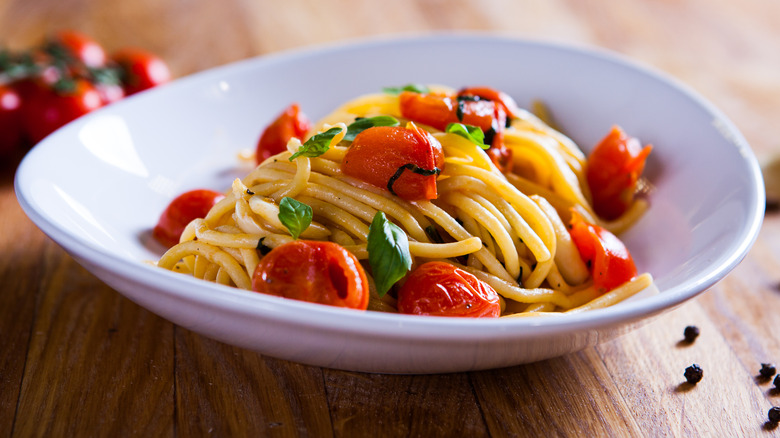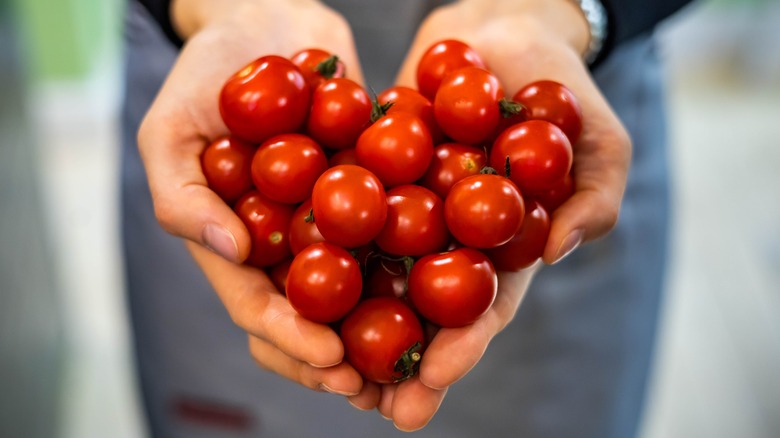Giada De Laurentiis' Summer Pasta Is The Solution To Endless Homegrown Tomatoes
There's nothing better than harvesting your own homegrown tomatoes. If you've got a green thumb and grow them in your own garden, then you know that, at the peak of the summer growing season, you might end up with more fresh tomatoes than you know what to do with. Giada De Laurentiis' marinated cherry tomato pasta is the perfect solution for a seemingly never-ending tomato bounty because it uses up a good amount of the little red gems, and makes their delicious, sweet, and tangy flavor, texture, and color the highlight of the dish.
This flavorful and simple vegetarian pasta recipe is made with just a few ingredients, most of which you probably have in your kitchen: tomatoes, shallots, garlic, lemon, olive oil, spaghetti, basil, and Parmesan. Everything but the pasta marinates together to magically transform plain pasta into a five-star Italian dish that you might expect to be served at one of Giada De Laurentiis' signature restaurants.
Aside from how deliciously appetizing it looks, the true beauty of this pasta recipe is that there's practically no cooking involved. Aside from a bit of chopping, the only other cooking step is to boil water for the pasta. The one caveat is that the marinade does need to sit from two to four hours for the flavors to fully develop, so either make it a day ahead or with at least a few hours to spare. Once the marinade is ready to use, the dish comes together in mere minutes.
Ripe cherry tomatoes star in this no-cook dish
This summer tomato pasta could not be any easier to make, as Giada De Laurentiis demonstrates in her TikTok video. The main step is to make the marinade ahead of time, which you will later use to sauce the pasta. Chop in half two pints of your freshly picked cherry tomatoes and combine in a large glass bowl with sliced shallot, two cloves of chopped garlic, juice and zest from two lemons, half a cup of extra virgin olive oil, and salt and red pepper flakes to taste. Cover and let it rest at room temperature for at least two to four hours.
Once the marinade flavors have fully infused the olive oil, the only thing you have left to do is make the pasta. Add one pound of spaghetti to boiling and properly salted pasta water, until it is al dente. Add the noodles to the marinade bowl and mix well. Top with fresh basil leaves and shaved Parmigiano Reggiano for a gourmet touch and cheesy finish that takes this pasta from humble to over the top.
@giadadelaurentiis I love this summer pasta! Recipe avail on @Giadzy by Giada De Laurentiis #summerpasta #fyp #freshpasta #pasta #pastatiktok
The recipe as written makes six servings, and the pasta tastes even more amazing the next day as leftovers. Giada eats it warm, but it's just as good cold, or reheated. Any way you want to serve it, it's a satisfying and filling meal on its own, perhaps with some garlic bread, or on the side with a hearty dish of classic Italian chicken Parmesan.
Variations on a theme
If you don't have the time or patience to wait for the marinade, Giada De Laurentiis has a very similar cherry tomato spaghetti recipe made with nearly all the same ingredients. The difference is in the technique — the cherry tomatoes are used whole and sauteed in olive oil until they start to burst. You'll get the same aromatic flavors and make use of your plentiful tomatoes, but this dish can be ready in under 30 minutes.
In another Giadzy recipe, De Laurentiis uses a variation of the same cherry tomato and oil marinade in her polenta alla caprese. In this dish, the tasty sauce is served over creamy polenta and topped with fresh mozzarella. In a pairing made in heaven, she also makes skewers from cubes of tomato and watermelon with basil, then drizzles them with a sweet balsamic glaze — the perfect end-of-summer evening meal.
If your tomatoes just keep on coming, and you've had your fill of canning them and making pasta, there are plenty more ways to use up your fresh-from-the-garden crop. You can dehydrate them to make sun-dried tomatoes, which can be snacked on as is, used as a topping for pizza and salads, or as an ingredient that adds complexity to pasta sauce. If you've got tomatoes in your garden, then you've also got the plant they grew on. Try cooking a no-waste tomato vine sauce that makes surprisingly clever use of the tender stems as well as the green leaves.



